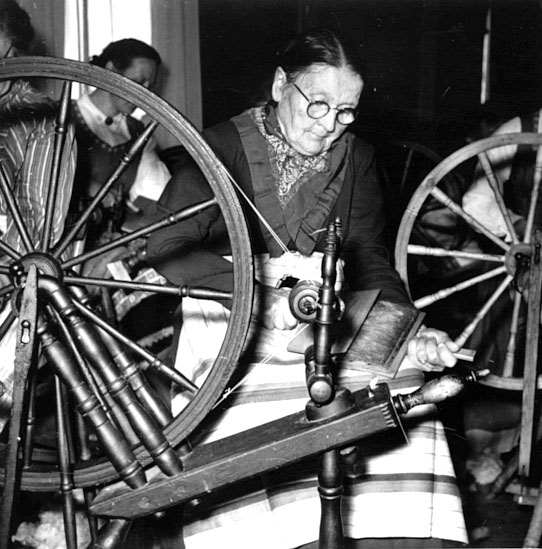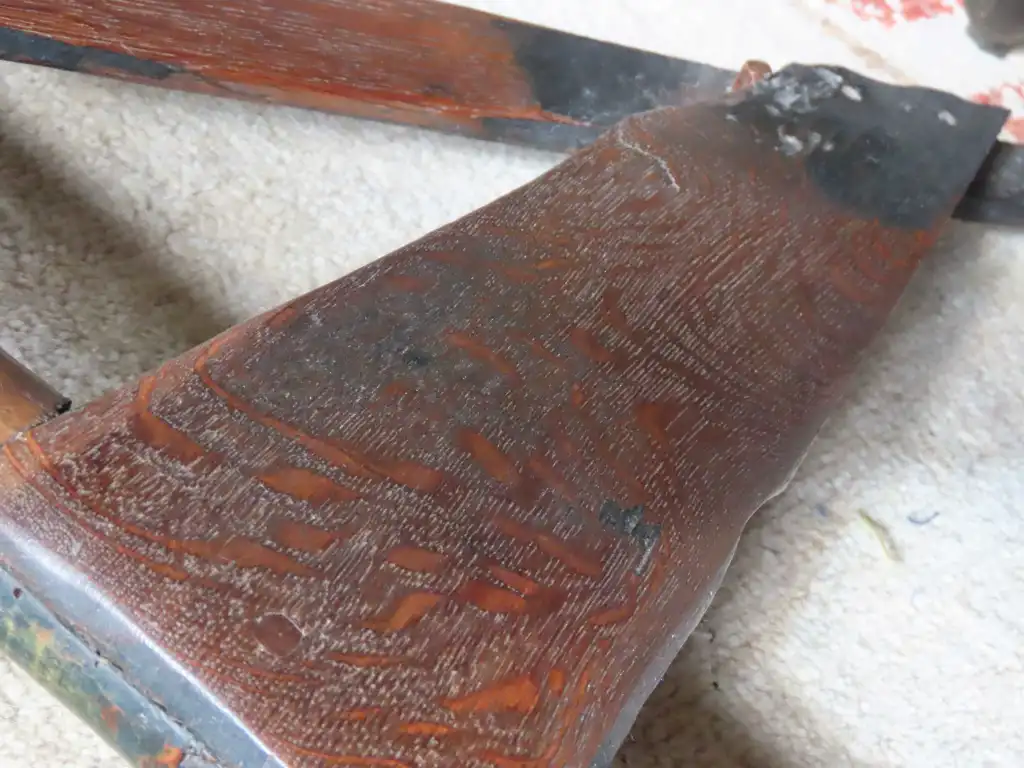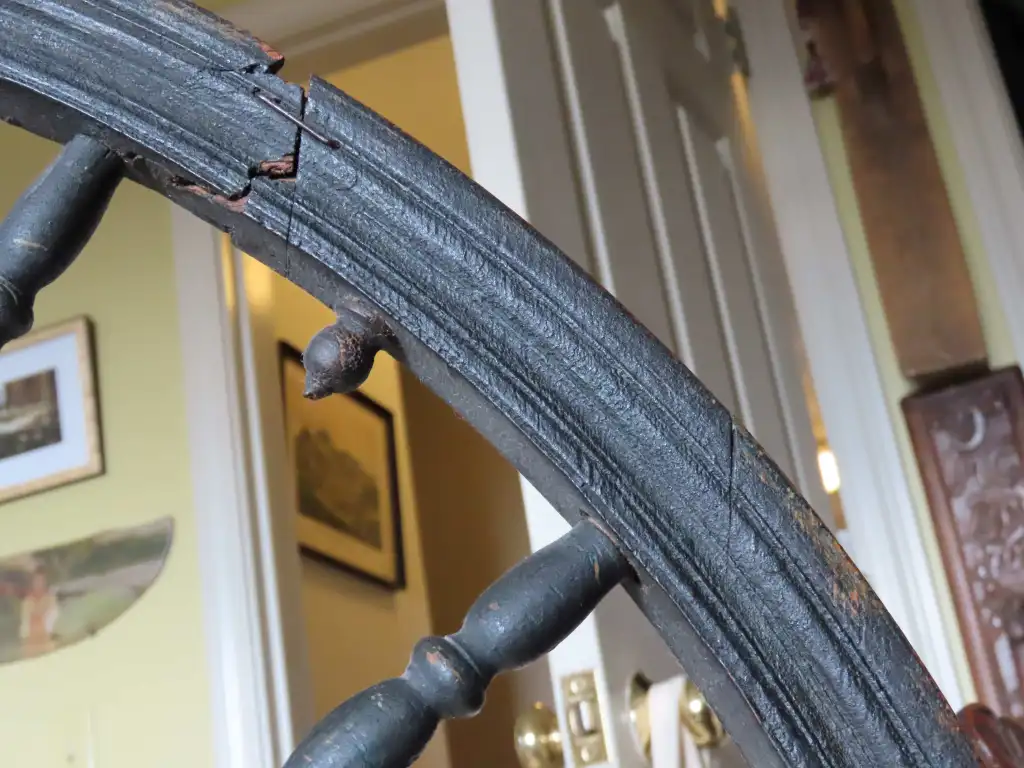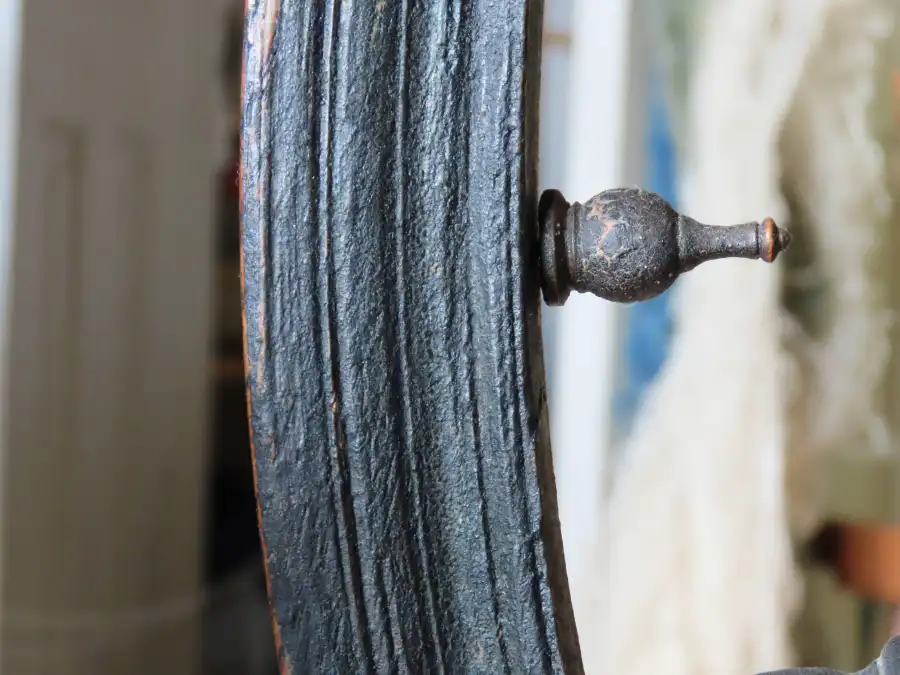
This wheel’s distinctive profile is immediately recognizable from across a room. Its rakish slant, impressive drive wheel, and closely set double upright supports combine for a unmistakable look. The wheel’s previous owner had brought the wheel to New Hampshire from Gothenburg, Sweden, where she had been living.

As far as she knew, the wheel had been made locally, somewhere near Gothenburg. A few sister wheels have shown up on Facebook and Ravelry, but with little information as to their origins. Recently, however, another showed up online as part of the “Lin on Me” linen exhibit at the Rydals Museum in Rydal, Sweden, east of Gothenburg. I checked with the museum and with others in Sweden knowledgeable about antique wheels and, while there seems to be agreement that the wheels are from Västra Götaland, the county (län) surrounding Gothenburg, no one seems to know the maker or town in which they were made.

They share some similarities with the beautiful Solberga wheels, but those typically are double rimmed. The photo below is a Solberga wheel, also from Västra Götaland. The photo is from the Upplandsmuseet, with more details here in Digitalt Museum: https://digitaltmuseum.se/011023874843/spinnrock


In the photo above, a woman is spinning in Bolum, also in Västra Götaland. Although the wheel is different than Amalia, it shares many features. More information on this photo is found here: https://digitaltmuseum.se/021017212168/spinning. For anyone researching Swedish wheels, I highly recommend the DigitaltMuseum: https://digitaltmuseum.se/search/?q=spinnrock&o=0&n=60 The search term “spinnrock” yields photographs from eight museums.
As with the Solberga wheels, Amalia’s most striking feature is the drive wheel.

With a 27 inch diameter, sixteen spokes, and decorative finial/half spokes, it was designed both for beauty and fast spinning. And there is no doubt this wheel was valued for its spinning, with telltale signs of heavy use. The axle area is so deeply encrusted with old grease, I hesitated to try to unscrew the axle retaining pegs. I did unscrew one, but left the other in place.

the back-side axle emerges from a sheath of thin crumpled metal.

The front had badly worn the bearing, requiring a bit of propping.

The paint wear on the spinner’s side is fascinating.

One maiden, one upright support, the table side,

and one leg have been rubbed clean of paint, revealing the smooth lustrous wood underneath.

It is interesting to speculate just how the wear occurred–perhaps a combination of hands and clothing (large skirts and sleeves, perhaps?) rubbing against the wheel for hours, days, months, and years.

Most of the treadle paint has worn off completely.

The treadle paint and wood wear show that the wheel was often treadled with two feet. The treadle bar appears to have been designed for treadling that way, with its widened sweep to easily accommodate and support the left foot.

The uphill leg was replaced and painted a lighter green.

All of the wheels of this style that I have seen were painted with a very dark green paint. In contrast, the flyer is not painted, which is not unusual on painted Scandinavian wheels.

On the other hand, it might indicate that the flyer is not original to the wheel.

Especially because it does not show as heavy use as the rest of the wheel. The flyer hooks are quite large.

The leather bearings look like they could be original.

The spinner-side flyer bearing is four-layered leather, riveted with nails.


To see how such bearings were made, here is a superb 1964 video of Swedish wheel maker, August Jonsson: Spinnrocken.
Amalia’s wheel is missing one spoke and several of the small half-spoke/finials. The wheel rim is unusually constructed with eight alternating short and long sections.



To help support the large wheel, there are long, smooth secondary uprights running down to each leg.

The drive wheel’s arched-top double upright supports are most often associated with Finnish wheels. But they are found on Swedish wheels, too. These are closer together than most, which add to this wheel’s elegant style.

The table is made of fairly coarse grained wood, rough on the underside, but with nicely turned (and worm/beetle hole riddled) bottoms to the upright supports. Several have old shims.


There is a spinner-side distaff hole, but no distaff.

And the table end and openings are nicely chip-carved.

The distance between the flyer and the drive wheel is very short, which is somewhat unusual for Swedish wheels. It does allow for a large drive wheel to fit in a smaller footprint, although the wheel is quite tall. As for spinning, the wheel is fast, smooth, and effortless. Hats off to her maker, wherever he was.


Beautiful wheel. I especially love the dark green coloring. Enjoy your spin!
LikeLike
Thank you. I love the paint color, too. It’s especially beautiful where there has been some wear and there is contrast with the natural wood.
LikeLike
What a gorgeous wheel and, as always, wonderful writing/research. What, if any, repairs/restorations do you plan? Love the grease and the wear marks.
LikeLike
I probably won’t do any restoration. It spins beautifully, so replacing the spoke and half spokes would be cosmetic. It would be impossible to match the dark, alligatored paint so any replacement parts would look like replacements. At this point, I’d rather leave it like it is. You never know, I might change my mind, though.
LikeLiked by 1 person
Thank you for the close up pics. And your observations. I have one somewhat similar tho there are several differences.
Can you tell me what material you used for your drive belt (red/white)? And do you ever coat it to make it smooth?
LikeLike
You’re welcome! Do you know anything about the history of your wheel? The drive belt is baker’s twine. I like the brand “Regency” (professional grade) because it is quite thin. I buy it at a local cooking store but sometimes you can get that brand online. If not, any baker’s twine works well, but some are thicker than others. I never coat it with anything. Nor do I splice the ends. Because it’s so thin, I just use a small square knot and it works beautifully. Actually, I think the band on this wheel is not the thinner Regency brand but a slightly thicker baker’s twine that I bought on Amazon. They all work!
LikeLike
A beautiful wheel and informative checklist of Swedish/Scandinavian features. I will use this list to study my similar wheel.
I always learn something from your blog. And you don’t stint on photos.
LikeLike
Ha! I try to photograph all of the distinctive features of each wheel so that they can compared with others and documented for posterity. It does lead to a lot of photos but also–I hope–gives a sense of the beauty in the small details of these amazing machines.
LikeLiked by 1 person